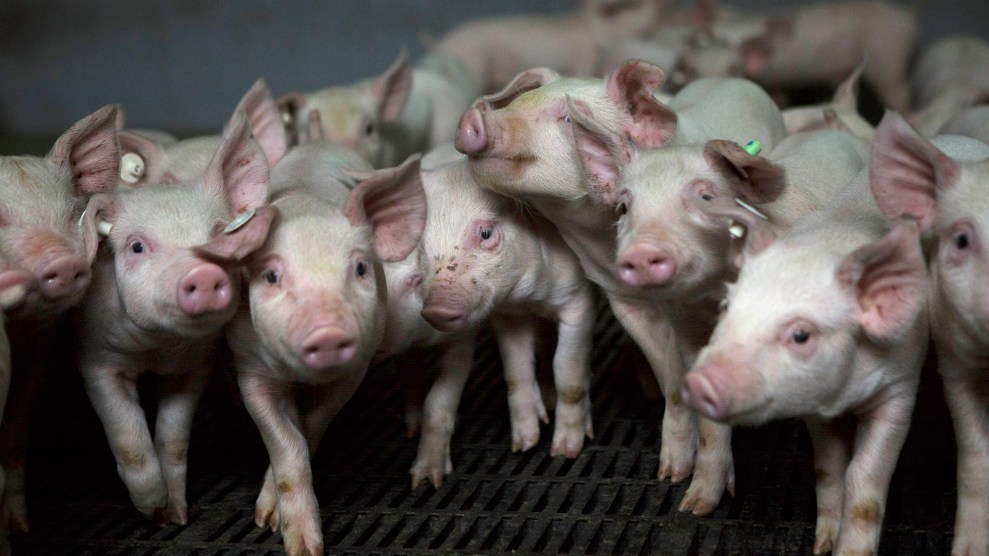
In June, President Donald Trump announced a 25 percent tariff on $50 billion worth of Chinese imports, officially launching his long promised trade war. Beijing retaliated immediately, imposing levies on American exports like soybeans and pork—goods reportedly selected to hit Trump country. Another round of tariffs followed in September, adding another $200 billion worth of Chinese products to the list. As corn and soybean prices slid, the administration announced a bailout of up to $12 billion to make up for the economic toll of retaliatory tariffs. But the preelection subsidy won’t reach all farmers, and low crop prices could mean unhappy rural voters.
Researchers at the Brookings Institution analyzed the impact of the tariffs so far and found that in rural areas, 13.4 percent of export-supported jobs were under threat as of September. In counties that voted for Trump, 8.2 percent of export-supported jobs were in danger, as opposed to 3.2 percent in counties that voted for Hillary Clinton, according to the New York Times.
Here are some midterm races where Trump’s trade policy could be less than tariff-ic for Republicans:
US Senate, Missouri: Sen. Claire McCaskill, who has support from the National Farmers Union, called the tariffs a “gut punch” to the Show-Me State’s agricultural sector, which centers around pork and soybeans. Her challenger, state Attorney General Josh Hawley, has an endorsement from the Missouri Farm Bureau. He hasn’t said whether he supports the Trump tariffs, but he backs the president’s effort to renegotiate trade deals.
1st District, Iowa: More than half the state’s top corn-producing counties are in this district, which is also a major soybean and pork producer. In June, Rep. Rod Blum joined the rest of Iowa’s largely Republican representation to warn of the tariffs’ impacts on Iowa farmers, only to thank the president a month later. A September poll found Democrat Abby Finkenauer, who has criticized Trump’s approach to trade, inching ahead of Blum.
3rd District, Iowa: Rep. David Young, who represents a district known for soybeans and farm equipment manufacturers, fought the tariffs before they were implemented and has admitted they make him “nervous.” But the Republican incumbent also said he has faith in Trump’s commitment to end the trade war. Cindy Axne, his Democratic challenger, said the tariffs have already cost the state’s soybean and pork producers $1 billion in lost profits this year.
4th District, Iowa: The state’s 4th District is ranked the second most agriculturally productive in the United States, and it’s home to the country’s most fruitful soybean-producing county. If threats to Iowa’s corn, soybean, and pork exports don’t cause voters to consider Democratic newcomer J.D. Scholten, a former baseball pitcher from a farming family, Republican incumbent Steve King’s extreme stances may: “Culture and demographics are our destiny,” the incumbent tweeted in March. “We can’t restore our civilization with somebody else’s babies.” Scholten has so far outraised King. And though the district traditionally votes red, polls conducted in early September found him 6 to 10 points behind his challenger, and Sabato’s Crystal Ball, a handicapper based out of the University of Virginia’s Center for Politics, in July moved King from “Safe Republican” to “Likely Republican.”
10th and 21st districts, California: When the Trump administration announced its farm bailout in July, California’s fruit and nut farmers got peanuts. More than two-thirds of California’s $5.6 billion almond crop is shipped to foreign markets, and nut growers now face a new 15 percent tariff in China. Republican Reps. Jeff Denham and David Valadao, whose districts are in the heart of almond country, co-signed a letter asking the White House to find an alternative to the tariffs. Denham has said that while “nobody wants the tariffs,” they will be good for the state’s agricultural sector in the long run. Valadao is up against T.J. Cox, a nut-processing-plant owner who has called the tariffs “dangerous and irresponsible.”
12th District, Illinois: Illinois is one of the top corn- and hog-producing states, and it’s a farm equipment manufacturer. Trump’s tariffs on imported steel and aluminum could mean trouble for smaller manufacturers and small to midsize farms. Republican Rep. Mike Bost applauded the steel tariffs, which he credited with helping to revive a local steel plant. But the local United Steelworkers union is backing Democrat Brendan Kelly.
US Senate, North Dakota: Democratic incumbent Heidi Heitkamp narrowly won this seat in 2012, and Republican challenger Rep. Kevin Cramer didn’t intend to run until Trump encouraged him to. Though Cramer’s official line is that the tariffs are not the best way to solve trade issues with China, he has said he likes how they represent Trump’s “America First” philosophy. Heitkamp has called the tariffs “unfortunate” and argued they treat rural America “like collateral damage.” With more than $14 million raised by both campaigns, the race is shaping up as one of the most expensive (per vote cast) in US history.













